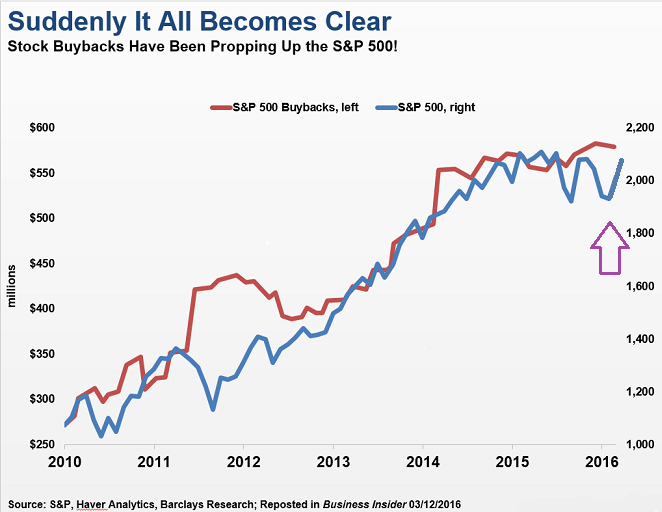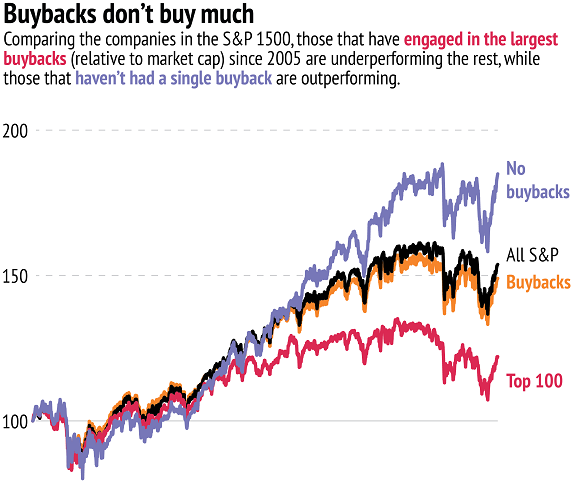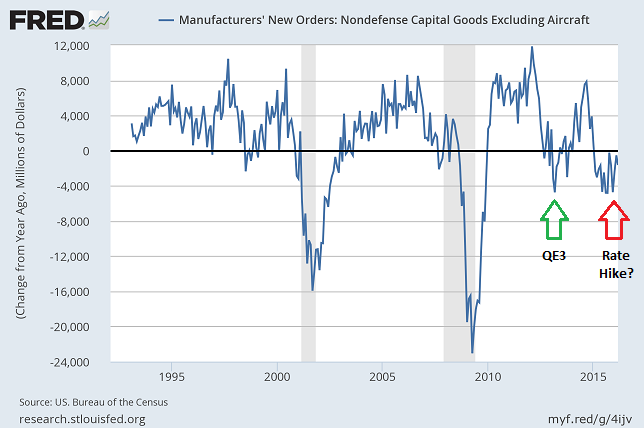Some facts are more interesting than others. For example, Liz Ann Sonders, chief investment strategist and perma-bull at Charles Schwab, recently acknowledged that:
“…there has not been a dollar added to the U.S. stock market since the end of the financial crisis by retail investors and pension funds.”
Let the reality sink in for a moment. “Mom-n-pop” investors as well as pension funds have not added to their U.S. equity positions during the seven-year-plus bull market. That includes the last three months in which major bank clients (e.g., hedge funds, private clients, institutional investors, etc.) have been net sellers.
Since every buyer has a seller (and vice versa), what group or groups had enough of a buying presence to push the S&P 500 14.2% off of the February closing lows? Corporations.

The notion that corporate share buybacks have been influential in propping up stocks is nothing new. On the flip side, the extent of the influence may be much greater than previously realized. Standard & Poor’s 500 Index constituents acquired roughly $182 billion of stock in the first quarter of 2016 alone. Even today, with real yields ticking up from 0.0% to 0.4%, companies may not wish to pass up the perceived opportunity to fund share acquisitions through ultra-cheap debt issuance.

Unfortunately, debt-funded buybacks present a number of challenges. First of all, total debt levels for U.S. companies have doubled since the Great Recession. While many analysts focus solely on the current ability for companies to service their debt obligations, the capacity for companies to do so changes when borrowing costs increase, free cash flow sinks and/or net income declines.
Consider free cash flow after dividends. This refers to the cash flow from operating activities excluding fixed capital expenditures and dividends paid. In Q4 of 2015, companies spent 101.7% of free cash flow after dividends. 101.7%! Not only was that a sizable year-over-year jump from Q4 2014 when the ratio chimed in near 81%, but it demonstrates that S&P 500 corporations (in aggregate) are now spending every free dollar on the support of stock prices. If they continue to spend every dime to support stock prices, rather than growing respective businesses via capital expenditures, the inevitable stagnation would hinder long-term profit prospects.
A second significant challenge to the buyback game? Companies that have spent more on stock buybacks are underperforming relative to those that have spent less on buybacks.
At some point, buyback activity may be reined in by executives who become cognizant of the underachievement, particularly if there are cash flow concerns. It follows that the stock market’s only buyer would require another major group to step up its participation, or the selling pressure would overwhelm current prices.

There is a third, more ominous complication associated with debt-funded buyback activity. Specifically, what would happen if credit conditions tightened? Even a modest tightening similar to what transpired in the first few months of 2016 would lead to trouble for corporations looking to finance and acquire shares. Whether spreads between Treasury bonds and corporate bonds (e.g., investment grade, high yield, etc.) widen, or whether global growth concerns slam the world’s financial institutions again, it is not far-fetched to imagine easy money access becoming a little less easy.
One way that a few folks are evaluating the current climate for stocks as well as the liquidity of corporations is by addressing the “Buyback to Free Cash Flow Ratio.” The higher the ratio, the more troublesome the environment. Unfortunately, at the current moment, the ratio is dangerously high – near the highest levels since the Great Recession ended (58.3%). And since corporations haven’t really slowed their insatiable appetite for buybacks just yet, the rising ratio represents aggregate free cash flow (S&P 500) dropping 9.5% on year-over-year basis. Translation? Stocks could fizzle out from their effervescent levels.

Total debt levels rising, net income declining, free cash flow falling, CEO realization of stock underperformance, higher borrowing costs/credit access issues. Any combination of these items is likely to inhibit the buyback support to overvalued S&P 500 equity prices.
Granted, there are eternally bullish advocates like Liz Ann Sonders who claim that retail investors and pension funds will pick up the slack when corporations stand down. (Really? These groups will suddenly add substantially to their stock allocations after seven years?) Ms. Sonders also believes that a softening in buybacks would simply morph into capital expenditures, and thereby boost corporate growth prospects going forward. The problem with that assumption? “Core CapEx” has rarely looked worse at a time when the Fed is not considering additional emergency easing measures.

For roughly one year, our tactical approach to asset allocation has called for a defensive bias. We downshifted our moderate growth-and-income clients from 65%-70% diversified growth (e.g., large-cap, small-cap, foreign, etc.) to 45%-50% high-quality stock. Appropriate ETFs in this arena include iShares MSCI Quality Factor (NYSE:QUAL), PowerShares S&P 500 Quality (NYSE:SPHQ) and/or iShares MSCI Minimum Volatility (NYSE:USMV).
We lowered moderate clients from 30%-35% diversified income (e.g., investment grade, higher yielding, foreign, etc.) to 25%-30% investment grade bonds. Appropriate ETFs for investment grade assets include SPDR Nuveen Municipal Bond (NYSE:TFI), iShares 7-10 Year Treasury (NYSE:IEF) as well as Vanguard Total Bond (NYSE:BND).
The resulting 20%-30% cash/cash equivalent allocation has buffered against several volatile 10%-plus corrections (i.e., August-September and January-February). We anticipate putting the cash back to work at lower prices when the S&P 500 reaches a bearish low-water mark (1705) and/or the Federal Reserve announces a fourth iteration of quantitative easing (QE4). Indeed, we concur with the assessment that the expansion of the Federal Reserve’s balance sheet has been responsible for 93% of stock gains since the bull market inception in March of 2009.
Disclosure: Gary Gordon, MS, CFP is the president of Pacific Park Financial, Inc., a Registered Investment Adviser with the SEC. Gary Gordon, Pacific Park Financial, Inc, and/or its clients may hold positions in the ETFs, mutual funds, and/or any investment asset mentioned above. The commentary does not constitute individualized investment advice. The opinions offered herein are not personalized recommendations to buy, sell or hold securities. At times, issuers of exchange-traded products compensate Pacific Park Financial, Inc. or its subsidiaries for advertising at the ETF Expert web site. ETF Expert content is created independently of any advertising relationships.
